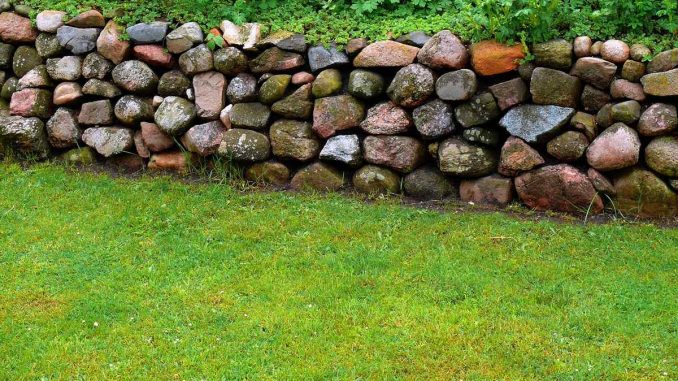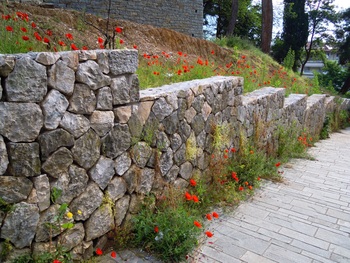
In landscaping and civil engineering, retaining walls are essential because they offer support and stop soil erosion on sloped terrain. These walls are not only functional but can also enhance the aesthetics of your property. Whether you need to create a leveled garden, reinforce embankments, or improve the overall appearance of your landscape, understanding the various types of retaining walls available is essential. This comprehensive guide will go through the different kinds of retaining walls, their characteristics, construction methods, and how they can raise the value of your property.
Gravity Retaining Walls
Description
Gravity-retaining walls rely on their mass and weight to retain the soil behind them. Usually, they are constructed out of heavy materials like brick, stone, or concrete.
Advantages
- Simple design and construction process.
- Suitable for low to medium-height retaining walls.
- Durable and long-lasting with minimal maintenance required.
Considerations
- It is necessary to accurately calculate the wall’s weight and thickness in order to maintain stability.
- Taller barriers or those in places with distinctive soil conditions may necessitate professional engineering advice.
Cantilever Retaining Walls
 Description
Description
Cantilever retaining walls consist of a horizontal base, a vertical wall, and an arm that extends back into the retained soil.
The extended arm provides additional support and stability.
Advantages
- Can be constructed in various materials, including concrete and masonry.
- Suitable for medium to high retaining walls.
- It has a sleek and sophisticated appearance.
Considerations
- Proper design and reinforcement are essential for optimal stability.
- Careful construction is required to ensure the wall can bear the pressure from the retained soil.
Sheet Pile Retaining Walls
Description
Sheet pile retaining walls are erected by driving interlocking steel, vinyl, or wood sheets into the ground to create a barrier against soil movement.
Advantages
- Ideal for areas with limited space and access.
- Quick and cost-effective installation process.
- Can be used as temporary or permanent retaining walls.
Considerations
- Not suitable for high retaining walls or areas with heavy loads.
- Requires professional installation to ensure proper alignment and stability.
Anchored Retaining Walls
Description
Anchored retaining walls use anchors or cables that extend horizontally into the soil behind the wall. These anchors provide additional support and prevent lateral movement.
Advantages
- Suitable for high retaining walls and areas with significant loads.
- Provides adaptability and stability
- Can be constructed using various materials.
Considerations
- Professional engineering and installation are necessary to ensure the anchors are properly placed and tensioned.
- May require periodic maintenance of the anchor system.
Gabion Retaining Walls
Description
Gabion retaining walls are constructed using wire mesh containers filled with rocks or stones. These containers are stacked to form a strong and flexible retaining wall.
Advantages
- Allows for water drainage, reducing hydrostatic pressure.
- Aesthetically pleasing and blends well with natural surroundings.
- Relatively easy and quick to construct.
Considerations
- Properly sized stones and appropriate mesh material are crucial for stability.
- Regular inspection and maintenance are necessary to prevent erosion or shifting.
Reinforced Soil Retaining Walls (RSRW)
Description
Reinforced soil retaining walls combine soil reinforcement techniques with traditional retaining wall structures. This method uses geogrids or geotextiles to enhance the soil’s stability.
 Advantages
Advantages
- Cost-effective and versatile.
- Greener aesthetics are possible because vegetation can be affixed to the wall.
- Suitable for a wide range of heights and soil conditions.
Considerations
- Proper compaction and placement of the reinforcement materials are essential for stability.
- May require professional engineering input for specific projects.
Conclusion
For projects including landscaping and civil engineering, retaining walls are crucial because they offer stability, erosion control, and improved aesthetics. It is possible to select the ideal retaining wall type for your particular needs and property if you are aware of the several types that are available. Each form of the wall has certain benefits and things to keep in mind, from sheet pile walls and anchored walls to cantilever walls and gravity retaining walls.
Whether you’re aiming to create a terraced garden, protect your property from soil erosion, or enhance the overall appearance of your landscape, investing in a well-designed and properly constructed retaining wall can add value to your property and provide long-lasting benefits. Consulting with a professional landscaping contractor or engineer can help you make informed decisions and ensure the success of your retaining wall project.

Leave a Reply